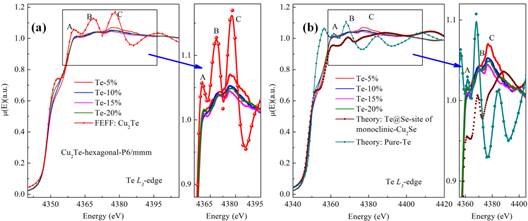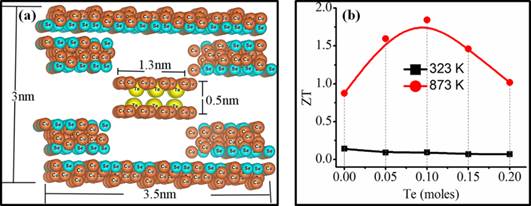| Enhanced thermoelectricity in superionic Cu2Se through embedded Cu2Te nanoclusters |
| From: PublishDate:2017-06-16 Hits: |
Thermoelectric materials are promising in thermal to electrical (vice versa) energy conversion applications. Nowadays the thermoelectric materials are becoming a spotlight of energy-related materials. For one thing, the thermoelectric devices can be applied in efficient utilization of waste-heat to generate power, which is also environment friendly. For another, the thermoelectric devices, thanks to their non-volatility and compactness, can be also engineered for refrigeration applications in aerospace crafts, detectors, etc. The Cu2Se based superionic conductor type thermoelectric materials hold great promises in high temperature applications (Figure of merit>1). The thermoelectric Figure of merit (ZT) value has been optimized to exceed 2 within a very narrow temperature window at 400 K. However, such a record for the Figure of merit was never achieved at high temperature.
Recently, a team consists of Dr. Sajid Butt of Prof. Ce-Wen Nan’s group from Tsinghua University and Dr. Wei Xu from Institute of High Energy Physics of CAS and their coworkers, has developed a superionic conductor Cu2Se based thermoelectrics embedded with Cu2Te nanoclusters. The Figure of merit was optimized to record high value ~1.9 at 873K. To unveil the origin of the enhanced thermoelectricity they have employed the 4B7A endstation of Beijing Synchrotron Radiation Facility. By combining the local structural probe-X-ray Absorption Near-edge Spectroscopy (XANES) and theoretical simulations using Full Multiple Scattering Theory (FMST), they have revealed the local structure of the enhanced superionic conductor Cu2Se thermoelectrics.
As shown in Figure.1, it is confirmed that Te ions formed Cu2Te nanoclusters via XANES at Te L3-edge using tender X-ray. As shown in Figure.2, the nanoclusters are effective scatterers for heat-carriers-phonons generated by lattice collective vibrations. Consequently the thermal conductivity was suppressed and the thermoelectricity was enhanced. In synergy with electron microscopy, they proposed a route to optimize the thermoelectricity of ionic conductor type Cu2Se thermoelectrics. The work was published on ACS Appl. Mat. Interfaces 8, (24), 15196-15204 (2016).
Figure.1 Local structure of dopants
Figure.2. Models for optimizing thermoelectricity via embedded Cu2Te nanoclusters Article: S. Butt, W. Xu*, M. U. Farooq, G. K. Ren, Q. Zhang, Y. Zhu, S. U. Khan, L. Liu, M. Yu, F. Mohmed, Y. Lin and C.-W. Nan, Enhanced Thermoelectricity in High-Temperature β-Phase Copper(I) Selenides Embedded with Cu2Te Nanoclusters, ACS Appl. Mat. Interfaces 8, 15196-15204. (2016) |
|
|
| Chinese
- Metal-free efficient photocatalyst for stable visible water splitting——Top ten major scientific progresses in China in 2015
- The nano-resolution imaging platform was awarded the first rate prize of Beijing Science and Technology in 2014
- Beamline 1W1 of BSRF started to runoperate in the couplingparasitic mode of BEPCII
- Synthesis of High Performance Polymer Materials for Field Effect-Transistors
- Surfactant molecular aggregates in green solvents
- GIXRD has played an important role in the characterization of organic thin-film transistors
Copyright © 2011 - 2012 Beijing Synchrotron Radiation Facility



